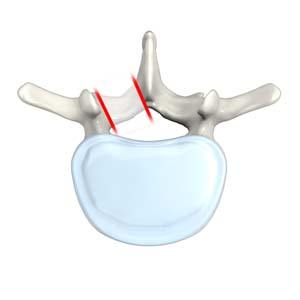
Spine Anatomy
The spine is surrounded and protected by vertebral bones stacked one on top of the other. Between adjacent vertebrae are spaces called neural foramen through which spinal nerves pass to communicate with the rest of your body.
Disease Overview
Conditions such as a herniated intervertebral disc or bony overgrowth may cause compression of the spinal nerves as they pass through the neural foramen. In the lower back or lumbar region, this can result in lower back pain as well as pain, weakness, and numbness in the legs.
What is Lumbar Foraminotomy?
A lumbar foraminotomy is a surgical procedure that decompresses the spinal nerves by removing bone and other tissues that obstruct the neural foramen.
Lumbar Foraminotomy Procedure
- You will lie face down.
- The site of surgery is identified by X-ray imaging.
- An incision is made on the skin.
- Tissues are separated and retracted to expose the affected area.
- Special instruments are inserted through the incisions to remove bone spurs, thickened ligaments, and all or part of the disc causing the nerve compression.
- A microscope is used to verify whether the decompression of the spinal nerves is complete. The instruments are then removed and the incision closed.
Postoperative Care following Lumbar Foraminotomy
You are usually discharged on the same day of surgery and may experience relief immediately after surgery. In case of pain, your doctor will prescribe medication. You will receive advice on wound care and activity limitation.
Risks and Complications of Lumbar Foraminotomy
As with any invasive procedure, a lumbar foraminotomy may be associated with certain complications such as infection, bleeding, nerve damage and leakage of spinal fluid.



